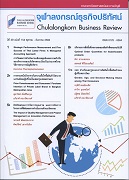เพศ ช่วงวัยและรูปแบบการตัดสินใจซื้อสินค้าของผู้บริโภคชาวไทย
Main Article Content
Abstract
บทคัดย่อ
รูปแบบการตัดสินใจซื้อของผู้บริโภค (Consumer Decision-making Style) มีความแตกต่างและมีลักษณะเฉพาะในแต่ละประเทศ งานวิจัยในอดีตที่ศึกษารูปแบบการตัดสินใจซื้อของผู้บริโภคในประเทศต่างๆ มักจะใช้เครื่องมือวัดที่เรียกว่า Consumer Styles Inventory ของ Sproles และ Kendall (1986) ซึ่งงานวิจัยของ Sproles และ Kendall (1986) เป็นศึกษารูปแบบการตัดสินใจซื้อของผู้บริโภคในประเทศสหรัฐอเมริกา การนำ Consumer Styles Inventory ไปใช้วัดรูปแบบการตัดสินใจซื้อในประเทศอื่น อาจทำให้ไม่สามารถวัดรูปแบบการตัดสินใจซื้อได้อย่างครอบคลุม งานวิจัยเรื่องนี้ มีวัตถุประสงค์เพื่อศึกษารูปแบบการตัดสินใจซื้อของผู้บริโภคชาวไทย ที่อาศัยในเขตกรุงเทพมหานคร เป็นการเสาะหาว่า รูปแบบการตัดสินใจซื้อใดบ้างที่มีความเกี่ยวข้อง (Relevancy) กับผู้บริโภคชาวไทย การศึกษานี้เป็นการวิจัยเชิงคุณภาพด้วยวิธีการวิจัยปรากฏการณ์วิทยา เก็บข้อมูลด้วยวิธีสัมภาษณ์กลุ่ม (Focus Group Interview) โดยจำแนกผู้ให้ข้อมูลตามเพศและช่วงวัยออกเป็น 6 กลุ่ม ผลการวิจัยพบรูปแบบการตัดสินใจซื้อที่เกี่ยวข้องกับผู้บริโภคชาวไทย ที่สอดคล้องกับรูปแบบการตัดสินใจซื้อของ Sproles และ Kendall (1986) ได้แก่ การใส่ใจในคุณภาพ การใส่ใจในราคาและความคุ้มค่า การซื้อเพราะเคยชินกับแบรนด์ การซื้อตามกระแสและความแปลกใหม่ และการใส่ใจในแบรนด์ ส่วนรูปแบบที่พบในผู้บริโภคชาวไทยแต่ไม่สอดคล้องกับรูปแบบการตัดสินใจซื้อของ Sproles และ Kendall (1986) ได้แก่ การไม่เห็นความแตกต่างระหว่างแบรนด์ การไม่มีความภักดีต่อร้านและแบรนด์ การเป็นผู้ใช้หลายแบรนด์ในเวลาเดียวกัน การใส่ใจในสไตล์ของตนเอง และการใส่ใจในสังคมและสิ่งแวดล้อม ผลวิจัยชี้ให้เห็นว่า รูปแบบการตัดสินใจซื้อของผู้บริโภคชาวไทยมีลักษณะเฉพาะ ดังนั้น เครื่องมือวัดรูปแบบการตัดสินใจซื้อควรเพิ่มเติมและปรับปรุงให้ครอบคลุมในทุกรูปแบบที่เกี่ยวข้อง ผลวิจัยสามารถนำไปเป็นแนวทางในการกำหนดกลุ่มลูกค้าเป้าหมายและกิจกรรมทางการตลาดที่สอดคล้องกับกลุ่มเป้าหมาย
Abstract
Consumer decision-making style in each indivudial country is different and unique. Previous research studing consumer decision-making style in their different countries usually have employed Sproles and Kendall’s (1986) “Consumer Styles Inventory,” which studied decision-making style of American consumers. As a result, the studies may not capture styles that are not included in Consumer Styles Inventory. The present research aims to explore consumer deicision-making styles that are relevant to Thai consumers living in Bangkok metropolitan areas. It is a qualitative research, using phenomenological approach. Collect data by focus group interview. Informants were divided into 6 groups, according to their gender and age group. Research result found decision-making styles which were also found in Sproles and Kendall’s (1986) consumer styles inventory. They are High-Quality Consciousness, Price Consciousness/Value for Money, Habitual Brand Loyalty, Novelty-Fashion Consciousness, and Brand Consciousness. In addition, the present study found decision-making styles that are relevant to the Thais but are not found in the consumer styles inventory. They are Indifference, Store/Brand Promiscuity, Multi-Brands User, Personal Style Conscious, and Social and Environmental Consciousness. Findings suggest that Thai consumers’ deicision-making style is unique; as a consequence, in order to successfully measure it, researchers should modify scale to capture decision-making styles relevant to Thai consumers. The results are the bases for managers to do segmentation and guidelines to design marketing tactics to penetrate each target group.
Article Details

This work is licensed under a Creative Commons Attribution-NonCommercial-NoDerivatives 4.0 International License.
Opinions and discussions in papers published by the Creative Business and Sustainability Journal (CBSJ) are deemed as personal opinions and the responsibility of the writers. They are not the opinions or responsibility of the Chulalongkorn Business School of Chulalongkorn University.
Papers, content, information etc. appearing in the Journal are deemed to be the copyright property of the Chulalongkorn Business School of Chulalongkorn University. Anybody or any organization that wishes to publish any part of them or use them in any way must obtain written permission from the Chulalongkorn Business School, Chulalongkorn University.


